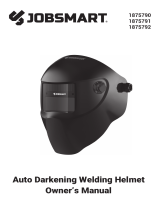
3
How to replace battery (For
Replaceable Battery Version Only)
When the LED (pos. 5) on ADF turns red, the battery needs
replacement. Follow instructions below. Otherwise, ADF
won’t work correct and can cause harm to the operator.
• Remove battery cover from battery case (pos. 1)
• Take battery out and t a new battery inside battery case.
Note: "+" is on top. (pos. 2)
• Assemble battery cover onto battery case.
Before using the lter:
We recommend the following adjustments to be made:
• Turn the sensitivity knob clockwise to the max. setting
(pos. 2). Depending upon the surrounding light the
lter will switch to the dark state or will icker (if the
surrounding light is very low, the lter may not switch
to the dark state).
• Turn back the sensitivity knob (pos. 2) until the lter
switches to the clear state.
• The lter is now set to its optimum sensitivity (Accord-
ing to the surrounding light conditions).
Range of use for the SAVAGE A40
All arc welding applications with the exception of TIG<5A.
Available shade - 9-13 (pos. 1).
Setting the delay
The clearing delay can be adjusted manually by turning the
delay knob (pos. 3) between a fast clear (0.1 sec) fully anti-
clockwise and a slow clear (1.0 sec) fully clockwise.
Spare parts SAVAGE A40
Items without a part number are not available as spare
parts.
No. Part No. Description
1 0700000480 SAVAGE A40 9-13 Black
1 0700000481 SAVAGE A40 9-13 Yellow
1 0700000490* SAVAGE A40 9-13 Replaceable Battery
Black
1 0700000491* SAVAGE A40 9-13 Replaceable Battery
Yellow
2 0700000483 ESAB Head Gear
3 0700000414 Sweat band
4 0700000010 Front cover lens
5 0700000482 Inside cover lens
6 0700000418 ADF cradle
7 0700000419 Lens retainer with screws
*Not Available in all regions.
Filter Testing:
Before use of the welding helmet the auto darkening lter
(ADF) and helmet needs to be checked according to the
following procedure:
1. Check outer protection lens is clean and can be seen
through.
2. Ensure the sensors are not covered in any way and
are clean.
Once these checks have been carried out you can now test
the ADF.
Turn the outside shade knob to the darkest setting (shade
13) and set the sensitivity to the highest setting (turning
clockwise). Now point the sensor towards a light source
such as an overhead light, lamp etc. The ADF should now
switch to the dark state (please note if the ADF is stored
in a dark area away from light it may need to be left out in
strong light for 20 minutes to absorb power, after 20 min-
utes if the ADF does still not react then there is an issue with
the sensor). Once the lter is in the dark state you can check
the shade variation is functioning correctly, simply turn the
shade knob anti-clockwise. By doing this, the shade should
get lighter. If the shade does not appear to alter then you
have an issue with the shade variation.
To test the delay function, set the delay to the maximum
setting. Now move the lter sensor away from the light
source it should take 1 second to return to the light state,
now after the delay setting to the minimum and repeat the
process, the time taken to return to the clear state should be
0.1 second. If the ADF does not react in this way, then there
is an issue with the delay function.
Testing the sensitivity. Set the sensitivity to minimum
setting now point the ADF at the light source you used to
test the other functions (if lter switches to dark state move
away until the lter returns to clear state) slowly turn the
sensitivity until the lter switches to dark state (if it does not
then move closer to the light until it reacts) if the ADF does
not react then there is an issue with the light sensors.
If any of the functions fail during test or in use, then please
do not use the ADF and contact your local distributor.
WARNING
The auto-darkening lters tted in the SAV-
AGE A40 helmets are not waterproof and
will not work properly if they have been in
contact with water.
Welding helmets and lters only resist a
certain amount of heat. Please do not place
them near naked ames or hot work areas
etc.
Operating temperature of electronic lter
minus 10º to plus 65º C.
Materials that may get in contact with the
wearers skin could cause Allergic reactions to
susceptible individuals.








